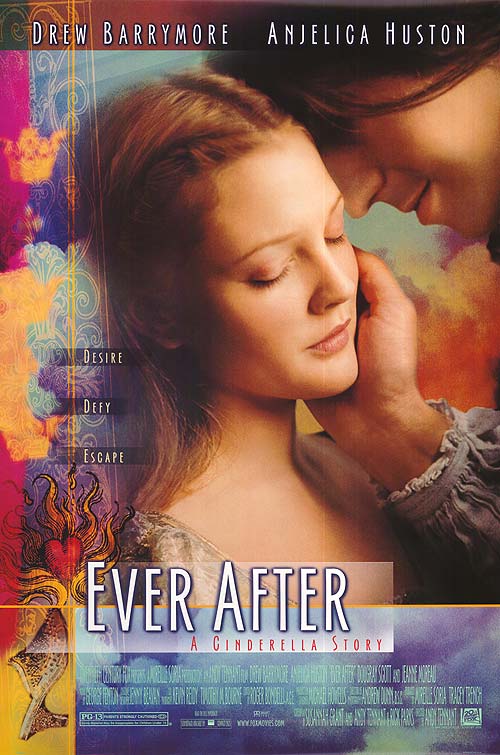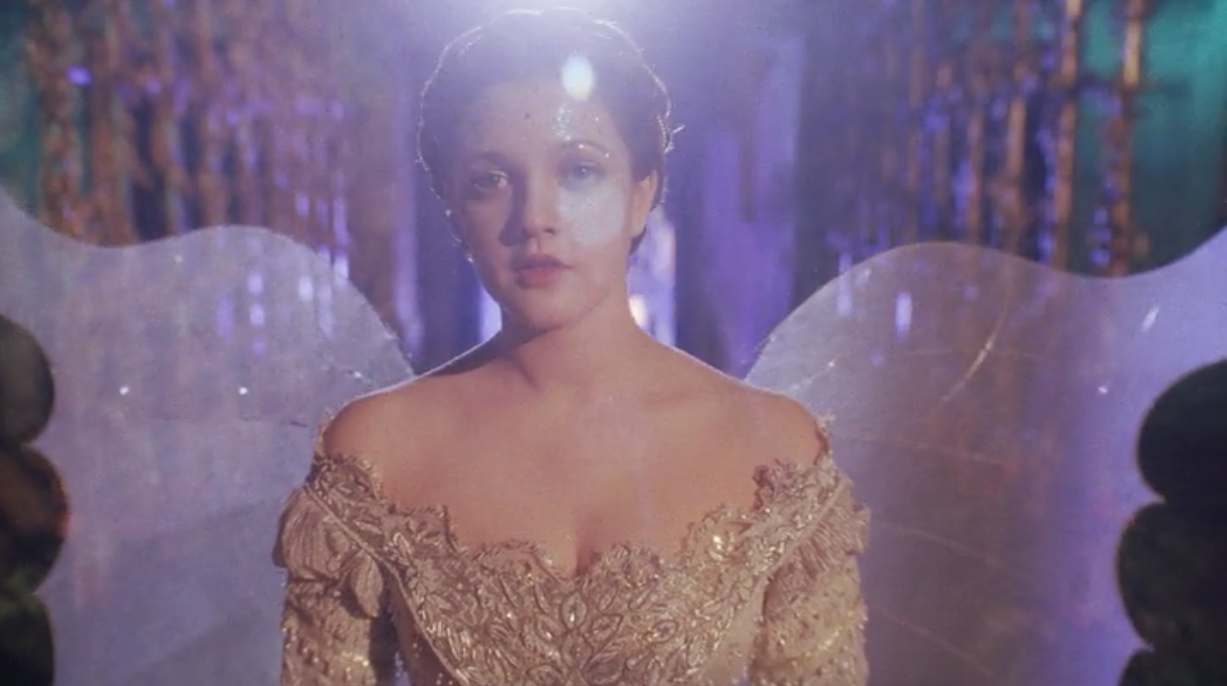Cinderella Week continues with abstew ...
 The Barrymores and the Hustons. Two dynasties that over decades and generations left their legacy on stage and screen, taking their place as acting royalty. It's fitting that the classic tale of the young cinder girl that manages to actually become royalty would finally bring these two families together on film. Other than a 1939 documentary about the history of America called Land of Liberty which contained footage of John and Lionel Barrymore and Walter Huston (and if you look at the cast list from IMDB, apparently every star in Hollywood at the time...), it was 1998's Ever After that marked the first time a member of the Barrymore family acted alongside a member of the Huston family. And for Drew Barrymore and Anjelica Huston, representing their respective families, the pairing proved to be as enchanting as the timeless tale.
The Barrymores and the Hustons. Two dynasties that over decades and generations left their legacy on stage and screen, taking their place as acting royalty. It's fitting that the classic tale of the young cinder girl that manages to actually become royalty would finally bring these two families together on film. Other than a 1939 documentary about the history of America called Land of Liberty which contained footage of John and Lionel Barrymore and Walter Huston (and if you look at the cast list from IMDB, apparently every star in Hollywood at the time...), it was 1998's Ever After that marked the first time a member of the Barrymore family acted alongside a member of the Huston family. And for Drew Barrymore and Anjelica Huston, representing their respective families, the pairing proved to be as enchanting as the timeless tale.
Unlike the other magical, musical versions of Cinderella that we've been discussing, in this version, made during the height of late '90s "Girl Power" our main character is far from passive and pet mice aren't trying to help win her the love of a prince. Renamed Danielle de Barbarac, you are more likely to find her reading a tattered copy of Sir Thomas More's Utopia and debating the worth of all human beings than you are to see her harmonizing with songbirds. Tough, determined, and able to fend for herself, thank you very much (punches, daggers, and apple throwing employed when need be), at one point in the film she even rescues the prince (Dougray Scott) by throwing him over her back and carrying him away. Screenwriter Susannah Grant (Erin Brockovich) created a modern woman (that just happens to be living in the 16th century) for modern audiences perfectly embodied by modern-day Drew Barrymore. [More...]

I have to admit that when casting a French set period piece utilizing British accents (the default for anything European), the first person to come to mind is not Drew. Although her grandfather was known for his work in Shakespeare, Drew's California, hippie, love child vibe and distinct voice seem much too modern for anything classically set (Drew did a great spoof of how she doesn't exactly fit her family's theatrical lineage when she hosted SNL in 2009). But her contemporary sensibility ends up working in her favor. By already casting Barrymore in the role, we go in knowing not to expect Disney's version of the character or even Rogers and Hammerstein's. With Barrymore we expect our heroine to have a little edge, a toughness, and her modern day take makes her more relatable. Which is not to say that Barrymore seems out of place dolled up in Renaissance garb and adopting a plummy English accent either. She looks and acts the part accordingly (and is helped when her ball gown is given a '90s flare with body glitter and Hot Topic fairy wings) and fits herself to the story and setting. Rather than imposing her style, she allows it to bubble beneath her performance.
As for Oscar winner Anjelica Huston as Danielle's conniving stepmother, Baroness Rodmilla de Ghent, the actress has already shown that she can play evil to perfection (you don't get to play the Grand High Witch being nice) and clearly relishes how unapologetically scheming the Baroness is. Huston's performance seems to consist of varying degrees of sly smirks, a cocked eyebrow, shady side eye, and devious laughter. Often all within the same scene:



And in this version of the story instead of dividing her social climbing priorities for both of her daughters, the Baroness is laser focused in bestowing her attention on a single favorite (Megan Dodds as the bratty Marguerite). There's something even more sinister about the way she treats her second daughter Jacqueline (played with sweet simplicity by friend of TFE Melanie Lynskey). It's one thing to have contempt for Danielle, whom she's only related to be marriage and perfectly fine with utilizing as free labor, but to be so cruel to your own flesh and blood (Jacqueline is continuously ridiculed, being called dumb or fat by mother and sister) takes a special type of woman - the sort of woman that Huston excels at playing.
But perhaps the largest change to the Cinderella story in this version is that it's not even a fairy tale at all. All the magic elements that are part of the original - fairy godmother, pumpkin carriage, a broken spell at midnight, even the famous glass slipper - have all been given a make-over. The world created in the film is much more realistic with Danielle now being saved to go to the ball by...Leonardo da Vinci. Yes, that Leonardo da Vinci. (Even his "Mona Lisa" makes a brief cameo appearance in the film.) The inventor and artist befriends our heroine and comes to her aid after her stepmother locks her in the kitchen preventing her from attending the ball. But instead of fashioning a gown with a magic wand, Danielle just wears a dress once owned by her mother and her shoes are actually decorated with glass beads. She does leave behind one of her shoes, but the prince already knows who she is as they have met several times before in the course of the film and the misplaced slipper seems more like a nod to the audience who expect it from a Cinderella story. But it kinda seems arbitrary to mention since it serves no function to the plot of the film. And I think it's hardly a spoiler to tell you that things end up working out happily ever after for Danielle and her prince (it happens to be the film's title after all). With all the modifications made to the plot, feminist character developments, and the once-in-a-lifetime union of two acting dynasties within the film, it's nice to know that some traditions are still worth keeping.
